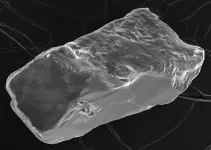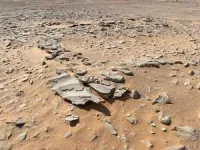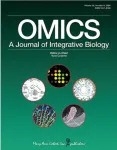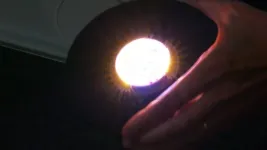(Press-News.org) Stanford researchers have developed an artificial intelligence-based tool – dubbed SandAI – that can reveal the history of quartz sand grains going back hundreds of millions of years. With SandAI, researchers can tell with high accuracy if wind, rivers, waves, or glacial movements shaped and deposited motes of sand.
The tool gives researchers a unique window into the past for geological and archeological studies, especially for eras and environments where few other clues, such as fossils, are preserved through time. SandAI’s approach, called microtextural analysis, can also help with modern-day forensic investigations into illegal sand mining and related issues.
“Working on sedimentary deposits that haven’t been disturbed or deformed feels about as close as you can get to being in a time machine – you’re seeing exactly what was on the surface of Earth, even hundreds of millions of years ago. SandAI adds another layer of detail to the information we can pull from them,” said Michael Hasson, a PhD candidate with Mathieu Lapôtre, an assistant professor of Earth and planetary sciences at the Stanford Doerr School of Sustainability. Hasson is lead author of a new study demonstrating the tool, published this week in Proceedings of the National Academy of Sciences.
Telltale signatures
Historically, microtextural analysis has been done by hand and eye, using magnifying glasses and microscopes to attempt to draw inferences about sand grains’ histories. Modern science has validated the approach, showing that transport mechanisms do indeed impart telltale signatures – for example, grains that traveled farther often appear more rounded because they’ve had their sharp corners dulled; waves and wind also leave distinctive abrasion patterns.
However, traditional microtextural analysis is highly subjective, time-consuming, and scattershot across different studies. Thanks to the new tool, which leverages the power of machine learning to deeply scrutinize microscopic images of sand grains, microtextural analysis can now be far more quantitative, objective, and potentially useful across a wide range of applications. It also analyzes individual sand grains instead of lumping multiple grains into a single category, offering a more complete evaluation.
“Instead of a human going through and deciding what one texture is versus another for sand grains, we are using machine learning to make microtextural analysis more objective and rigorous,” said Lapôtre, who is senior author of the paper. “Our tool is opening doors for microtextural analysis applications that were not available before.”
Worldwide, sand is the most used resource, after water, and is critical in the construction industry. Materials such as concrete, mortar, and some plasters require angular sand for proper adhesion and stability. Gauging the origins of sand, however, to ensure ethical and legal sourcing is challenging, so the researchers hope SandAI can bolster traceability. For example, SandAI could help forensics investigators crack down on illegal sand mining and dredging.
Training the tool
To build SandAI, the researchers employed a neural network that “learns” in a manner akin to the human brain, where correct answers strengthen connections between artificial neurons, or nodes, in the program, enabling the computer to learn from its mistakes.
With help from collaborators around the world, Hasson assembled hundreds of scanning electron microscope images of sand grains, representing material from the most common terrestrial environments: fluvial (rivers and streams), eolian (windblown sediments, such as sand dunes), glacial, and beach.
“We wanted this method to work across geological time, but also across all of the geography that we have on Earth,” said Hasson. “So, for example, the windblown dunes class was designed to include examples that are wet and dry, large and small. We needed the classes to be as diverse as they possibly could be.”
SandAI analyzed this set of images to train itself to predict the sand grains’ histories based on features that human researchers might not ever discern. The tool naturally made errors and would then iteratively improve. Once SandAI reached a robust 90% prediction accuracy, the researchers introduced new samples the model had not previously seen.
With images of sandstones from well-characterized environments ranging from the current day back to roughly 200 million years into the Jurassic era, SandAI performed well, correctly elucidating the grains’ transport histories.
Novel science and applications
Next, the researchers challenged the tool with images of sand grains collected from Norway that date back more than 600 million years to the Cryogenian period. Better known as the time of “Snowball Earth,” this was when ice sheets are thought to have covered the whole planet, before plants and animals had evolved. The origin of the sample in question, called the Bråvika Member, has been contested, with various research groups coming to different conclusions.
“With this Cryogenian sample, we were seeing how far we can push SandAI and really using it to do new science rather than just verifying that the tool worked,” Hasson said.
Intriguingly, SandAI surmised that the ancient sand grains had been shaped and deposited as part of a windblown sand dune – in agreement with some manual microtextural studies. Moreover, because the tool analyzes individual sand grains, versus lumping multiple grains into a single category, other details emerged. While the dominant signature indeed indicated wind transport, a secondary signature that manual techniques would likely miss pointed to glacial sand. Together, those signals paint a portrait of sand dunes running somewhere near a glacier, as might well be expected during the Snowball Earth period.
To evaluate those findings further, Hasson and colleagues looked for a potential modern analog of this Cryogenian geological scene. The researchers ran windblown sand grains from Antarctica through SandAI and, sure enough, arrived at the same result. “These findings from SandAI suggest that Antarctica really is a good modern analog to the environment represented by the Bråvika Member,” Hasson said. “They are a really strong piece of evidence that the signal we got from the Cryogenian deposits isn’t just a fluke.”
The researchers have made SandAI available online for anyone to use. They plan to continue developing it based on user feedback and look forward to seeing the tool applied in a range of contexts.
“The fact that we can now offer detailed conclusions about geological deposits that weren’t knowable before I find kind of mind-blowing,” said Hasson. “We’re looking forward to seeing what else SandAI can do.”
END
Introducing SandAI: A tool for scanning sand grains that opens windows into recent time and the deep past
2024-09-16
ELSE PRESS RELEASES FROM THIS DATE:
Critical crops’ alternative way to succeed in heat and drought
2024-09-16
Scientists have discovered that certain plants can survive stressful, dry conditions by controlling water loss through their leaves without relying on their usual mechanism - tiny pores known as ‘stomata’.
Nonstomatal control of transpiration in maize, sorghum, and proso millet – all C4 crops which are critical for global food security – gives these plants an advantage in maintaining a beneficial microclimate for photosynthesis within their leaves.
This allows the plants to absorb carbon dioxide ...
Students with multiple marginalized identities face barriers to sports participation
2024-09-16
MINNEAPOLIS/ST. PAUL (09/16/2024) — The U.S. Department of Health and Human Services Healthy People 2030 plan sets a national objective to increase youth sports participation from 50% to 63% over the next five years. For adolescents, staying active offers benefits to their overall health and their social and academic lives. However, the number of youths participating in physical activity and sports is on the decline. While participation gaps based on single social identities ...
Purdue deep-learning innovation secures semiconductors against counterfeit chips
2024-09-16
WEST LAFAYETTE, Ind. — Researchers in Purdue University’s College of Engineering have developed a patent-pending optical counterfeit detection method for chips used in semiconductor devices.
The Purdue method is called RAPTOR, or residual attention-based processing of tampered optical responses. It leverages deep learning to identify tampering. It improves upon traditional methods, which face challenges in scalability and discriminating between natural degradation and adversarial tampering.
Alexander Kildishev, professor in the Elmore ...
Will digital health meet precision medicine? A new systematic review says it is about time
2024-09-16
A new systematic review of pharmacogenomics clinical decision support systems used in clinical practice in the peer-reviewed OMICS: A Journal of Integrative Biology suggests that these e-health tools can help accelerate pharmacogenomics, precision/personalized medicine, and digital health emergence in everyday clinical practice worldwide. Click here to read the article now.
Anastasia Farmaki, MSc, from the Centre for Research and Technology Hellas, Thessaloniki, and coauthors in Greece, conducted a systematic review that examined and mapped the pharmacogenomics-clinical decision support ...
Improving eye tracking to assess brain disorders
2024-09-16
A University of Houston engineering team has developed wearable sensors to examine eye movement to assess brain disorders or damage to the brain. Many brain diseases and problems show up as eye symptoms, often before other symptoms appear.
You see, eyes are not merely a window into the soul, as poets would have it. These incredibly precious organs are also an extension of the brain and can provide early warning signs of brain-related disorders and information on what causes them. Examining the eyes can also help track the progression and symptoms of physical and mental shocks to the brain.
Researchers say ...
Hebrew University’s professor Haitham Amal is among a large $17 million grant consortium for pioneering autism research
2024-09-16
Hebrew University of Jerusalem is proud to announce that Professor Haitham Amal is among a large $17M grant consortium for pioneering autism research. This grant is part of an American funding initiative awarded by the California Institute for Regenerative Medicine (CIRM), aimed at advancing cutting-edge autism studies.
A world-renowned expert in nitric oxide and brain disorders, Professor Amal has made groundbreaking discoveries in autism research. His team was the first to identify a direct link between nitric oxide levels in the brain and autism spectrum disorder (ASD), a finding with profound implications for the ...
Scientists mix sky’s splendid hues to reset circadian clocks
2024-09-16
Those mesmerizing blue and orange hues in the sky at the start and end of a sunny day might have an essential role in setting humans’ internal clocks.
In new research from the University of Washington in Seattle, a novel LED light that emits alternating wavelengths of orange and blue outpaced two other light devices in advancing melatonin levels in a small group of study participants.
Published in the Journal of Biological Rhythms, the finding appears to establish a new benchmark in humans’ ability to influence their circadian rhythms, and reflects an effective new approach to counteract seasonal affective disorder (SAD).
A ...
Society for Neuroscience 2024 Outstanding Career and Research Achievements
2024-09-16
Embargoed until Monday, September 16, noon EDT Contact: development@sfn.org
CHICAGO – The Society of Neuroscience (SfN) will honor leading researchers whose groundbreaking work has transformed neuroscience — including the understanding of pain, addiction, stress, synaptic transport, vision, and sleep — with this year’s Outstanding Career and Research Achievement Awards. The awards will be presented during SfN’s annual ...
Society for Neuroscience 2024 Early Career Scientists’ Achievements and Research Awards
2024-09-16
Embargoed until Monday, September 16, noon EDT Contact: development@sfn.org
CHICAGO – The Society for Neuroscience (SfN) will honor nine early career researchers whose work will be presented during Neuroscience 2024, SfN's annual meeting.
“Early career researchers are often the ones who bring fresh ideas and perspectives to the field,” said SfN President Marina Picciotto. “These awardees and their novel approaches to microscopy, machine learning, circuits and behavior ...
Society for Neuroscience 2024 Education and Outreach Awards
2024-09-16
Embargoed until Monday, September 16, noon EDT Contact: development@sfn.org
CHICAGO – The Society for Neuroscience (SfN) will present six neuroscientists with this year’s Science Education and Outreach Awards, comprising the Award for Education in Neuroscience, the Science Educator Award, and the Next Generation Awards. The awards will be presented during SfN’s annual meeting.
“The Society is honored to recognize these passionate neuroscientists ...



